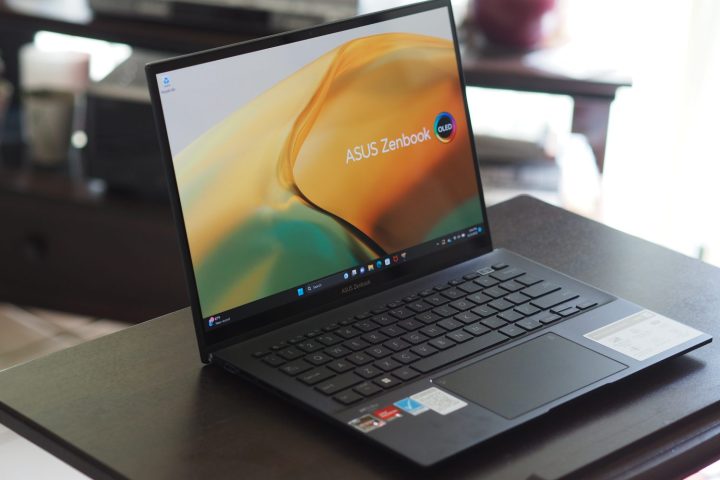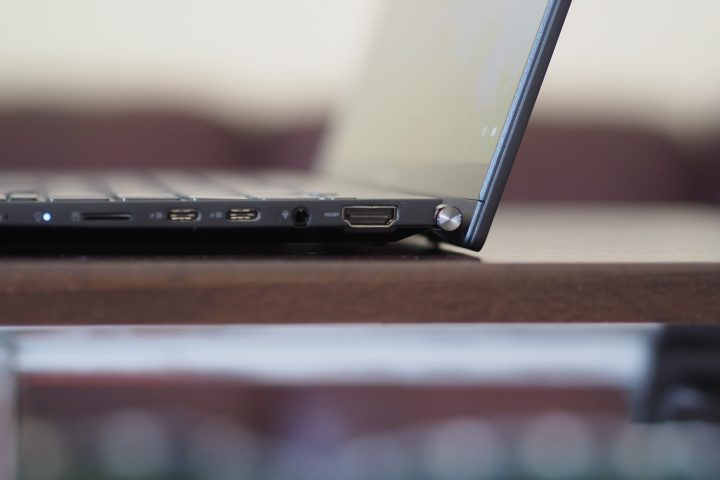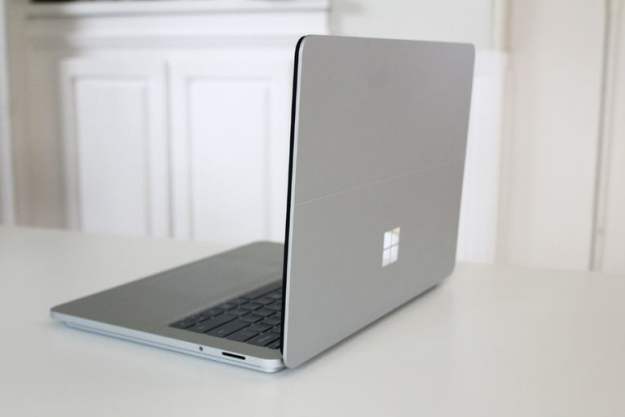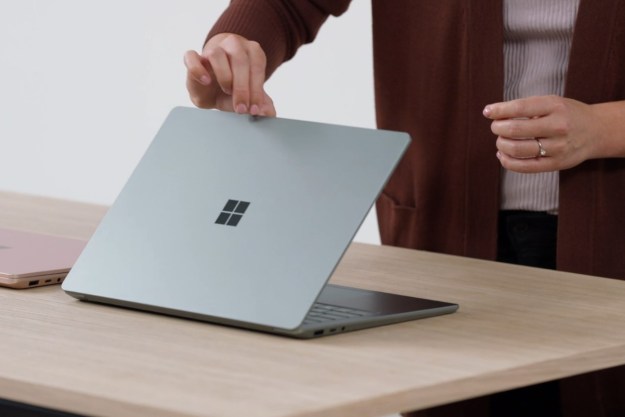
Microsoft has introduced the third generation of its ostensibly budget laptop offering. Starting at $800, the diminutive Surface Laptop Go 3 is actually priced more as a midrange laptop, which is even more true at its $1,000 upgrade price. For this much money, there’s a lot of strong competition.
One of the most attractive competitors is the Asus Zenbook 14 OLED. It’s a very well-built and well-designed laptop that starts at $700 and includes a larger 14-inch OLED display. Not only does it come with a much nicer screen, Asus’ laptop is faster and cheaper.
Specs and configurations
| Asus ZenBook 14 OLED | Microsoft Surface Laptop Go 3 | |
| Dimensions | 12.34 inches x 8.68 inches x 0.67 inches | 10.95 inches x 8.12 inches x 0.0.62 inches |
| Weight | 3.06 pounds | 2.49 pounds |
| Processor | AMD Ryzen 5 7530U AMD Ryzen 7 7730U |
Intel Core i5-1235U |
| Graphics | AMD Radeon graphics | Intel Iris Xe |
| RAM | 8GB 16GB |
8GB 16GB |
| Display | 14.0-inch 16:10 2.8K (2,880 x 1,800) OLED, 90Hz | 12.4-inch 3:2 PixelSense 1,536 x 1,024 IPS display |
| Storage | 256GB SSD 512GB SSD |
256GB SSD |
| Touch | Yes | Yes |
| Ports | 2 x USB-C 3.2 Gen 2 1 x USB-A 3.2 Gen 2 1 x HDMI 2.0 1 x 3.5mm audio jack 1 x microSD card reader |
1 x USB-C 3.2 1 x USB-A 3.1 1 x 3.5mm audio jack 1 x Surface Connect port |
| Wireless | Wi-Fi 6E and Bluetooth 5.2 | Wi-Fi 6 and Bluetooth 5.1 |
| Webcam | 1080p | 720p |
| Operating system | Windows 11 | Windows 11 |
| Battery | 75 watt-hours | 41 watt-hours |
| Price | $700+ | $800+ |
| Rating | 4.5 out of 5 stars | 2 out of 5 stars |
The Zenbook 14 OLED has two configurations, starting at $700 for an AMD Ryzen 5 7530U CPU, 8GB of RAM, a 256GB SSD, and a 14.0-inch 2.8K OLED display. Depending on where you buy it, the higher-end model costs around $1,000 for an AMD Ryzen 7 7730U, 16GB of RAM, and a 512GB SSD.
The Surface Laptop Go 3 starts at $800 for an Intel Core i5-1235U, 8GB of RAM, a 256GB SSD, and a 12.4-inch IPS display running at 1,536 x 1,024. For $1,000, the laptop is upgraded to 16GB of
As we’ll see, the Zenbook 14 OLED represents a much better value at either price.
Design

The Surface Laptop Go 3 is an attractive device, following the general Surface aesthetic with minimalist lines and angles that nevertheless evoke an image of quality and elegance. It’s available in four attractive colors: Platinum, Ice Blue, Sage, and Sandstone. The Zenbook 14 OLED is also minimalist and comes across as a bit more pedestrian in Ponder Blue, but it’s also attractive.
The Surface is constructed of a mix of aluminum in the lid and keyboard deck, and plastic on the bottom chassis. The latter contributes to its low weight of 2.49 pounds, but the lid is quite flexible, with LCD distortion from slight pressure. The Zenbook 14 OLED is made of all aluminum and is a bit more rigid. It’s also heavier at 3.06 pounds with its larger 14-inch display compared to the Surface’s 12.4-inch panel.
The Surface Laptop Go 3’s keyboard feels a bit cramped, with smaller keycaps and limited key spacing. The switches are also a bit stiff, with an uncomfortable bottoming action. It’s not the best Surface keyboard by a wide margin. The Zenbook 14 OLED’s keyboard is wider, with larger keycaps and more key spacing, and its switches are lighter and snappier. The Surface’s touchpad is small, but works well, while the Zenbook’s touchpad is larger, but similar in performance, although it also adds in an LED numeric keypad that’s easy to switch on and off. Both laptops offer touch displays.
Connectivity favors the Zenbook 14 OLED, which is no surprise given the extra chassis space. It has more numerous and diverse ports, although neither device has Thunderbolt 4 support. With the Zenbook, that’s due to the AMD chipset, while Microsoft simply decided not to include support. The Zenbook also benefits from a microSD card reader. The Surface Laptop Go 3 is limited to last-gen wireless connectivity, while the Zenbook is up to date.
The Zenbook 14 OLED has a higher-quality 1080p webcam versus the Surface Laptop Go 3’s 720p version, and it’s much better for videoconferencing. Both laptops lack infrared cameras for Windows 11 Hello facial recognition, but the fingerprint readers built into the power buttons worked well in our testing.
Performance

The Surface Laptop Go 3 uses an Intel Core i5-1235U processor, running at 15 watts and featuring 10 cores (two Performance and eight Efficient) and 20 threads. It’s a last-gen CPU that makes sense in a budget laptop, but not a contemporary midrange machine. The Zenbook 14 OLED offers either the AMD Ryzen 5 7530U or Ryzen 7 7730U. The former is a 6-core/12-thread CPU and the latter is an 8-core/16-thread chip. We reviewed the Zenbook with the Ryzen 5.
Simply put, the Zenbook was considerably faster than the Surface Laptop Go 3. Typical productivity users with a light workload of web browsing, email, Outlook applications, and the like probably won’t notice the difference. But anyone who runs more demanding applications that utilize multiple cores will definitely find the Surface slower than they’d like.
| Asus ZenBook 14 OLED (Ryzen 5 7530U) |
Microsoft Surface Laptop Go 3 (Core i5-1235U) |
|
| Geekbench 5 (single / multi) |
Bal: 1,457 / 7,527 Perf: 1,458 / 8,207 |
Bal: 1,179 / 5,652 Perf: 1,524 / 6,226 |
| Handbrake (seconds) |
Bal: 123 Perf: 121 |
Bal: 194 Perf: 214 |
| Cinebench R23 (single / multi) |
Bal: 1,457 / 7,527 Perf: 1,458 / 8,207 |
Bal: 1,118 / 5,170 Perf: 1,534 / 4894 |
| PCMark 10 Complete | 5,817 | 4,227 |
Display and audio

The Surface Laptop Go 3’s 12.4 inch 3:2 display has a very low resolution of just 1,536 x 1,024, which results in pixelated text and video that runs at less than 1080p. The Zenbook 14 OLED’s 14-inch 16:10 display is much higher resolution at 2,880 x 1,800.
According to our colorimeters, the Zenbook 14 OLED’s display is also far more colorful and had much higher contrast, producing inky blacks. The Surface Laptop Go 3’s IPS display simply isn’t in the same class.
Productivity workers, creators, and media consumers alike will love the Zenbook’s display and be a lot less happy with the Surface.
| Asus ZenBook 14 OLED (OLED) |
Microsoft Surface Laptop Go 3 (IPS) |
|
| Brightness (nits) |
369 | 354 |
| AdobeRGB gamut | 96% | 71% |
| sRGB gamut | 100% | 96% |
| Accuracy (DeltaE, lower is better) |
1.44 | 3.41 |
| Contrast ratio | 25,660:1 | 1,060:1 |
The Surface Laptop Go 3 uses OmniSonic speakers that project up through the keyboard, and they provide surprisingly good audio. There’s plenty of volume, clear mids and highs, and an uncharacteristic touch of bass. That’s much better than the dual speakers on the ZenBook 14 OLED, which were quieter and much less expensive.
Portability and battery

The Surface Laptop Go 3 is a much smaller laptop thanks to its more diminutive display, and it’s also lighter. Interestingly, it’s a little thicker than the Zenbook 14 OLED. It will be easier to carry around, although the Zenbook isn’t overly large or heavy.
When it comes to battery life, though, the larger battery capacity and AMD efficiency resulted in the Zenbook 14 OLED having much longer battery life. This was particularly true in our web-browsing test, where the Zenbook enjoyed almost twice the longevity. It might last a full day of light work, while the Surface definitely will not.
| Asus ZenBook 14 OLED (Ryzen 5 7530U) |
Microsoft Surface Laptop Go 3 (Core i5-1235U) |
|
| Web browsing | 12 hours, 13 minutes | 6 hours, 29 minutes |
| Video | 17 hours, 19 minutes | 13 hours, 35 minutes |
The Zenbook 14 OLED is a much better value
The Surface Laptop Go 3 would be a great laptop at the original version’s price of $550. At $800, though, that’s $100 more than the superior Zenbook 14 OLED. The Zenbook is faster, has longer battery life, and sports an OLED panel that’s in another class entirely.
This is about as one-sided a comparison as we’ve done in quite some time. The Zenbook 14 OLED is a much better value and a much better laptop than the Surface Laptop Go 3.
Editors' Recommendations
- This is one of my favorite Windows laptops. But can it beat the MacBook Air?
- Surface Laptop Go 3 vs. Surface Pro 7+: is it an upgrade?
- Surface Laptop Go 3 specs: what’s the best configuration?
- Microsoft’s Surface Laptop Go 3 is a more capable budget laptop
- This Windows laptop costs under $1,000 and handily beats the MacBook Air


